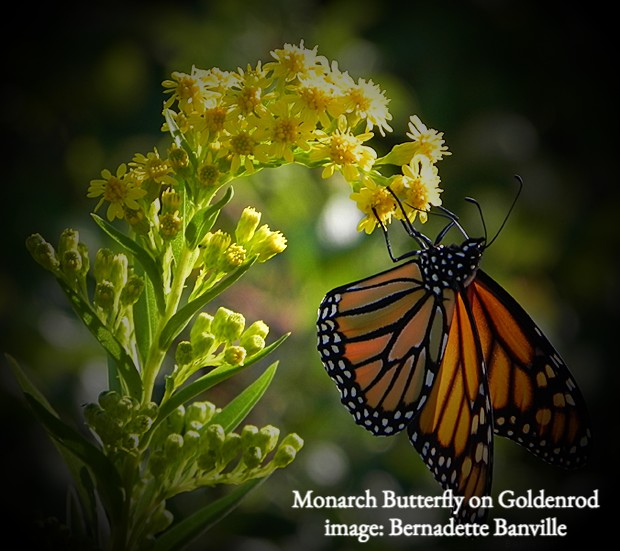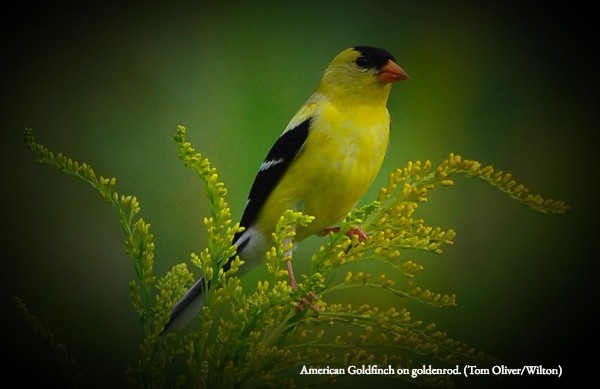By Deb Lebow Aal

Many of us know this plant, Goldenrod (Solidago), although it is often overlooked in the garden. It has lovely yellow flowers that bloom just as everything else is fading in your garden. It sways beautifully in the wind, and is a lovely companion plant to purple asters in the fall. Despite being quite sedate and not as showy as other garden favorites, Goldenrod is an essential addition to any home landscape. Goldenrod is native to the Front Range, is an easy plant to grow, and most importantly, it supports more caterpillar species than any other perennial.
Why is supporting caterpillar species important? For those of you who haven’t watched the movie Hometown Habitat, or heard Doug Tallamy1 speak, here’s the reason! Birds are dependent on caterpillars and if you want to support birds, you have to establish caterpillar habitat in your yard. Most baby birds eat caterpillars, and they eat a lot of them. To survive, a baby bird needs many hundreds, if not thousands, of caterpillars in the few weeks it is in the nest. Without the right host plants, your landscape will simply not provide an adequate supply of caterpillars to support a diverse bird population. So, just how beneficial is Goldenrod? Astoundingly, Goldenrod serves as a host2 to 79 butterfly and moth species’ caterpillars. For comparison purposes, 22 butterfly and moth species use Rocky Mountain Penstemon, another common native perennial, as a host for their caterpillars, and only, six species use Veronica (Speedwell), a non-native. Further, Goldenrod is an attractive source of nectar for bees, flies, wasps, and butterflies.

Goldenrod is valued highly by Native Americans for its many uses including the edibility of the young leaves and the plant’s ability to be made into an herbal tea. In some places, Goldenrod is considered a sign of good luck and fortune, much like Hens and Chicks. Goldenrod is in the Aster family, spreads by underground rhizome, and can survive well up to 7,000 feet in elevation. Like many native plants in this region, it is drought tolerant, once established. Goldenrod prefers full sun, but will tolerate partial shade and grows between 12 and 36 inches tall. This allows it to be a nice plant for the back border of your flower bed. There are several species of Solidago native to this area, however, when purchasing, make sure you are purchasing a native species3 and not a cultivar (a plant variety that has been produced by selective breeding, which may no longer have the properties of the native.)***
There is a false narrative surrounding Goldenrod in which it is stated to cause allergies. Ragweed, which blooms at the same time, causes allergic reactions, not Goldenrod. The pollen produced by Goldenrod is heavy and is rarely airborne, primarily being spread by pollinating insects. Additionally, some view the fact that Goldenrod spreads as a downside because it spreads a lot! In fact, it spreads so much it was long considered a weed by many in North America (In Europe it has been a prized garden plant for a long time). I, however, view the fact that Goldenrod spreads as a lovely positive. It allows me to divide this beautiful plant and put it in many places in my landscape.

Goldenrod supports a multitude of wildlife, and in particular, birds, better than any other perennial you can plant in your garden. In my yard, I have only one stand of Goldenrod. It has done exceptionally well in a hot, dry area. I am going to divide it this spring, hope to have it interspersed in every bed I have, and then sit back and watch the birds, butterflies and bees whizz by me.
Curious to learn more about transforming your garden into a habitat with Colorado native wildflowers, grasses, shrubs, and trees? Check out our native gardening toolkit, register for an upcoming event, subscribe to our newsletter, and/or become a member – if you’re not one already!
- Doug Tallamy is the author of Bringing Nature Home, is the founder of Homegrown National Park, and is heavily featured in the film Hometown Habitat. He is a professor of entomology at the University of Delaware. ↩︎
- Enter your zip code on the National Wildife Federation’s Native Plant Finder to get a list of native plants with the number of butterfly and moth species that use them as host plants for their caterpillars. ↩︎
- The Colorado Plant Database is an excellent resource for determining if a plant species is native. Here is a comprehensive list of native Goldenrod species from the database. ↩︎
